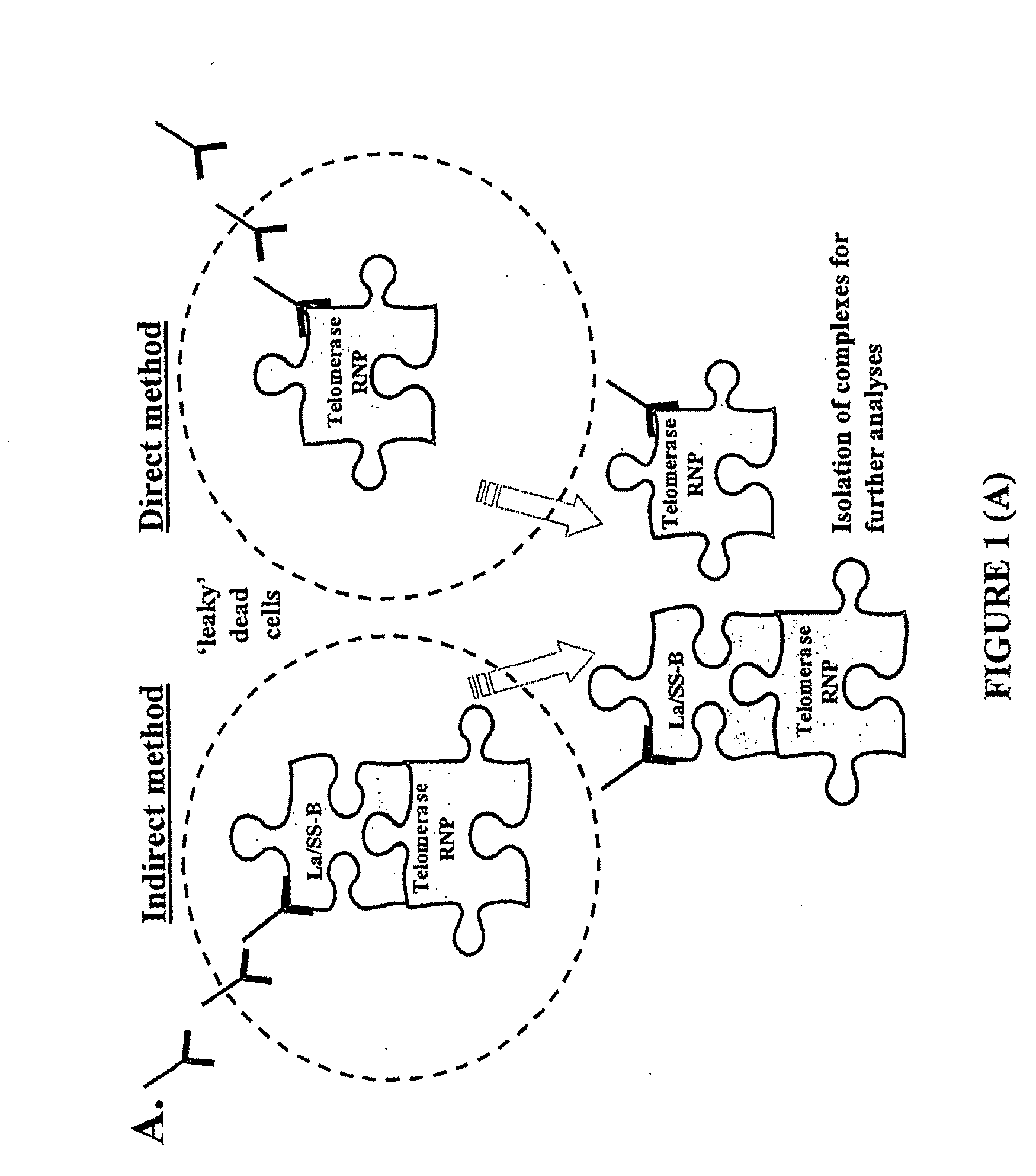Method of Diagnosis and Treatment and Agents Useful for Same
a neoplasm and cell death technology, applied in the field of neoplasm cell death screening for the level of neoplasm in a subject, can solve the problems of unsustainable immunological approaches to cancer treatment for over a century, severe side effects, and cancer is likely to become the most common fatal disease in these countries, so as to inhibit, reduce or otherwise down-regulate the growth of neoplasm, reduce or reduce the effect of
- Summary
- Abstract
- Description
- Claims
- Application Information
AI Technical Summary
Benefits of technology
Problems solved by technology
Method used
Image
Examples
example 1
Materials and Methods
In Vitro Culture and Apoptosis Induction of Human Peripheral Blood Mononuclear Cells and Human Jurkat T Cell Leukemia Cells.
[0168]Peripheral blood mononuclear cells (PBMC) were prepared from a buffy coat of a discarded unit of whole blood that had been obtained from the South Australian Red Cross Blood Bank. Initially, PBMC had been separated by density gradient centrifugation over Lymphoprep (Axis-Shield, Dundee, UK) and frozen in aliquots using a controlled rate freezer. Subsequently, the aliquoted cells were thawed and again purified over Lymphoprep to obtain viable cells. PBMC were grown in RPMI supplemented with 10% foetal calf serum (FCS), 50μ / mL penicillin and 50 μg / mL streptomycin sulphate (JRH Biosciences, Lenexa, Kans., USA) for 72 h. Half of the culture was treated with the T cell mitogen, conconavalin A (ConA) (Sigma, St Louis, Mo., USA), 10 μg / mL, and half of the culture was left untreated. After culture, cells were again purified over Lymphoprep to...
example 2
Material and Methods
Cytotoxic Drug Treatment of Cancer Cell Lines In Vitro
[0175]H69 cells were cultured in RPMI-1640 containing 5% fetal calf serum (FCS) and 400 μg / mL etoposide. Aliquots were removed at 24 h, 48 h and 72 h, and washed with phosphate-buffered saline (PBS) and then stained for cytofluographic analysis.
Enrichment of Circulating Tumour Cells from Blood of a Small Cell Lung Cancer (SCLC) Patient
[0176]Blood samples (2.5 mL) collected in heparinised tubes were enriched for expression of the BerEP4 epithelial cell adhesion molecule (EpCAM) using the CELLection™ Epithelial Enrich kit as per the manufacturer's instructions (Dynal® Biotech, Invitrogen Corp., USA). Briefly, 250 μL BerEP4-beads were mixed with the blood sample for 30 min. at RT. Beads were bound to a Dynal® magnet and washed 5 times with PBS. Bead-bound cells were released from the magnet using PBS containing 0.1% bovine serum albumin (BSA) and deoxyribonuclease I (DNase I) as described by the manufacturer. The...
example 3
Materials and Methods
Materials
[0189]Cell culture media, RPMI 1640, DMEM and Trypsin EDTA were obtained from JRH Biosciences Inc (Lexona Kans., USA). Staurosporine and ethidium bromide were obtained from Sigma-Aldrich Co. (St Louis, Mo., USA) Trizol and Superscript II were purchased from Invitrogen (Carlsbad, Calif., USA) and Amplitaq Gold from Applied Biosystems (Foster City, Calif., USA) All primers were manufactured by Geneworks (Adelaide, SA)
Cell Lines and Culture
[0190]Jurkat cells (ATCC #TIB-152) were maintained in RPMI 1640 supplemented with 5% fetal calf serum (FCS). U2OS cells (ATCC #HTB-96) were maintained in DMEM supplemented with 5% FCS and passaged every 48-72 hours after detachment with Trypsin EDTA. Jurkat cells express telomerase and thus have the integral RNA component, hTR, whereas U2OS cells lack telomerase and hTR. Apoptosis was induced by the addition of 0.5 μM staurosporine to the culture media for 24, 48 or 72 hours.
RNA Extraction and Reverse Transcription
[0191]...
PUM
| Property | Measurement | Unit |
|---|---|---|
| Cell death | aaaaa | aaaaa |
| Solubility (mass) | aaaaa | aaaaa |
| Time | aaaaa | aaaaa |
Abstract
Description
Claims
Application Information
 Login to View More
Login to View More - R&D
- Intellectual Property
- Life Sciences
- Materials
- Tech Scout
- Unparalleled Data Quality
- Higher Quality Content
- 60% Fewer Hallucinations
Browse by: Latest US Patents, China's latest patents, Technical Efficacy Thesaurus, Application Domain, Technology Topic, Popular Technical Reports.
© 2025 PatSnap. All rights reserved.Legal|Privacy policy|Modern Slavery Act Transparency Statement|Sitemap|About US| Contact US: help@patsnap.com



